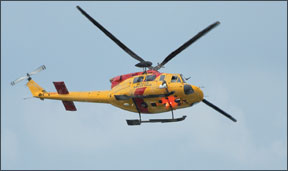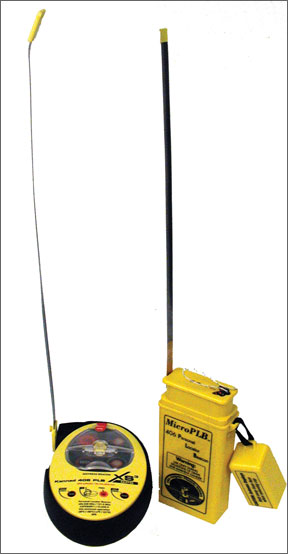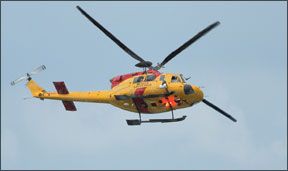Emergency locator transmitters (ELTs) are one piece of equipment airplane owners love to hate. They don’t work very we’ll and they always seem to need replacement batteries. Beginning next year, the government will cease satellite monitoring of 121.5 MHz ELTs, making what didnt work that we’ll to begin with instantly all but useless. Rather than invest as much as $4000 in a new 406 MHz ELT, one option owners have asked us about is carrying one of the new 406 MHz, GPS-enhanced portable locator beacons or PLBs. Theyre relatively inexpensive, have a good record thus far and can do double duty as an ELT and a rescue-me beacon for the car, the boat or outdoor activities of all kinds. While this makes sense, there are some limitations. Read on. On February 1, 2009, COSPAS-SARSAT, the international organization formed to oversee the ELT satellite-monitoring network, will stop listening for the 121.5 and 243.0 MHz signals from traditional ELTs. A new ELT standard (TSO C126) using digital technology and 406.025 MHz is a huge step forward, but these arent required equipment. Yet. The FAA so far has refused to expand the ELT requirement to embrace 406 ELTs and until prices for these come down from the flight levels, PLBs remain an attractive alternative. We looked at five current-generation models from five different manufacturers. While they all perform the same basic task-broadcasting your location with a GPS fix encoded-there are differences between them. Worth noting here is that the oversight agencies take a dim view of setting these things off willy-nilly to see if they work, thus we were unable to test them in the heat of battle. For that reason, our evaluations are based on examination of the units and their specifications and interviews with the manufacturers. For a detailed live test of PLBs, we recommend reading a report on the trials conducted by the Equipped to Survive Foundation at www.equipped.org. New models, including some covered here, have been introduced since that test was conducted.
Overview
Current-generation PLBs are basically a portable 406 ELT without the crash-impact activation feature. You have to switch it on manually, something which involves extending an antenna and pressing a button. PLB designs are of two basic types: With or without a built-in GPS receiver. Sending the GPS coordinates to the satellite can narrow down the effective search area from within a 5 kilometer radius when using 406 MHz Doppler shift techniques to 100 meters, which also eliminates the multiple-pass delay. That alone makes a PLB with built-in GPS the way to go, in our view.
All of these PLBs comply with international standards and, by regulation, the Federal Communications Commission (FCC) has adopted those standards as its own. A PLB must be FCC-approved before it can be registered in the U.S. And the free registration is necessary if owners expect to get the full benefit of a PLB, since each one carries a discrete digital signature thats part of its transmitted signal. All of the units we examined have some means to test and verify their operation, but without radiating signals. Also, just because two PLBs meet required specs, doesnt necessarily mean they perform equally under all conditions.
ACR MicroFix
ACR Electronics MicroFix PLB is about the same size and weight as a cellphone circa 1998, but without the day-glow green plastic shell. Also missing is a telephone keypad; there are only two buttons on the MicroFix, one to activate its self-test function and the other to get rescued. The “get-rescued” button is hidden under a tab attached to the antennas base and cant be pressed without first extending the antenna.
The antenna itself is a black-coated, flat, spring-steel affair-think metal tape measure-wrapped around the unit when in storage. The antennas tip, molded from the same day-glow green plastic, fits into a locking slot opposite the antennas pivot point. A lanyard and a black plastic snap-on belt carrier round out the package.
Activation is simple: Swing up the antenna, removing the tip from its recess, then press and hold the on/off button for one second. A pictogram on the front depicts extending the antenna and pressing the activation button, but it doesnt suggest holding the button.
GME Accusat MT410G
GMEs Accusat MT410G, manufactured in Australia, is vaguely rectangular in shape and encased in international-yellow plastic. Atop the unit is a built-in strobe light; more about that later. The unit has no LEDs, no push buttons and no cute styling. It comes with a black soft protective case, which includes a belt loop and a hook-and-loop closure.
On its back side is the antenna: Push to release a spring-loaded plastic latch and pull up and away from the unit to break a security seal, extending the stainless-steel cable antenna. Thats it-the unit is activated and is zapping its message to the nearest satellite. This is the only PLB of which were aware thats equipped with a built-in strobe light. Its not nearly as bright as an aircraft strobe, but it does work and is a feature present in none of the other units we considered. It would easily be visible to searchers using night vision gear.
Kannad 406 XS-3 GPS
Kannad is a subsidiary of the France-based Martec Group known in the U.S. for a line of ELTs variously marketed under both company names. The 406 XS-3 GPS model is the companys third-generation PLB and comes with a six-year battery, exceeded only by the GME Accusat MT410G. Its oval shape distinguishes it from the rest of the PLBs we examined.
The Kannad uses the same tape-measure-style antenna as the other units and this fits into a channel of soft black plastic wrapped around the PLBs circumference.

Once unwrapped, its base pivots and the antenna points straight up. Clear plastic shields cover the units buttons: Lift one shield to uncover the test button. To activate the PLB, break a small piece of red security tape, pop off the other shield and press the “ON” button. A pictogram explains it all.
The 406 XS-3 GPS is the least-expensive of the units we tried, but is among the heaviest. The units heft, however, inspires confidence even if were unconvinced that the plastic shields covering the buttons will survive long in a flight bag. They seemed fragile to us. The plastic wrapped around its circumference to store the antenna is easy to grip, even when wet. A good feature.
McMurdo Fastfind MAX-G
McMurdo, based in the U.K., was one of the first companies to enter the PLB market. At our deadline, its new-generation Fastfind MAX-G hadnt been approved for U.S. sale by the FCC, but approval was expected in May. The Fastfind MAX-G is packaged in a curvy yellow-plastic case. Included is a coiled lanyard, stretching up to two feet, with a heavy-duty plastic clip on the end for attaching to a belt loop, life raft or personal flotation device.
Its front is a flip-up door used to expose its control panel. The doors underside features two pictograms explaining activation. That involves first pulling off a red plastic cover, releasing the antenna and powering up the unit. The PLBs antenna is narrower spring-steel than others and is coiled up beneath the red cover. Once the red cover is removed, the antenna is free to extend and could smack someone whos holding it too close. Some care is necessary when deploying it. The Fastfind MAX-G is the only PLB with a user-replaceable battery, but it also has the shortest factory warranty. At 300 grams, its the heaviest in our roundup, but it does float. It comes with a yellow fabric case that includes a belt loop and a flap with hook-and-loop closure.
MicroPLB GX
Microwave Monolithics MicroPLB is the smallest PLB we looked at, with a form factor roughly the size of a pack of cigarettes, but taller. Its packaged in international-yellow plastic with black text describing the two-step process of activating it: Remove the small cap at the top, then withdraw an inch-long plastic activator pin on a short lanyard. Be careful, though, since pulling off the cap releases another spring-steel antenna that whips out like a jack-in-the-box, startling the unwary. The units cap remains nearby once its removed, thanks to a lanyard adapted from a shoelace and looped through molded lugs.
While its not the lightest, it is the smallest unit in our roundup and it would fit easily into a shirt pocket. There’s no belt loop or carrying case, but it really doesnt need one and it will hide just about anywhere in the cockpit or cabin until its called upon. The only mark against the MicroPLB is price: At $898, its the most expensive product in this group. And for that kind of money, we deserve better than a shoelace for a lanyard, in our view.
Conclusion
So, come next year, youre facing a dilemma. Legacy 121.5 ELTs will no longer be satellite monitored so the obvious question is why worry about it? Just buy one of these PLBs and be done with it. Is that a realistic way to approach this? We think it is. But its not without tradeoffs. A 406 ELT with GPS is designed to survive a crash and broadcast take-it-to-the-bank position data to get you found. Our view is that 406 ELTs are an order of magnitude better than 121.5 ELTs, although long-term reliability is still an unknown. They also cost between $2000 and $5000 installed. And although the NTSB has recommended that the FAA require owners to have them, the FAA has so far declined.
For a fraction of this cost, a PLB will get you found…if it and you survive the crash and the gadget can be manually activated. So the cost/value relates to how much youre willing to spend for an in-airplane beacon that will watch your back automatically versus one that requires manual operation. We think the PLB is a reasonable second choice-but it wont provide the same level of worst-case protection that a 406 ELT will. If budget isn’t a factor, buy both and know youve done all you can on the SAR front.
In our view, the GME Accusat MT401G is the best choice. Its price is competitive, its the lightest of the bunch, is roughly the same size as other PLBs and it floats. Its also the only PLB we looked at with a built-in strobe. The MT410G also has the longest shelf life and warranty-seven years for both-of any PLB we examined, although we might service it more frequently than that. Other choices, in order, are the Kannad, ACR and McMurdo. All have basically the same features, are easy to activate and are priced within $109 of each other.
Meanwhile, at almost $900, the only thing the MicroPLB has going for it that we can see is its small size. If you wanted a PLB to do double-duty for hiking or mountain biking, size and weight would be important. In that case, the MicroPLB might deserve another look.
Until someone markets an inexpensive GPS-equipped 406 ELT, a PLB with GPS may be best way to be found quickly after a remote crash. After January of next year-especially if you fly off the beaten path where there may not be any airliners overhead listening to 121.5-one of these PLBs may be the only way to get rescued at all.
Jeb Burnside is
Aviation Consumers associate editor and editor of Aviation Safety magazine.

